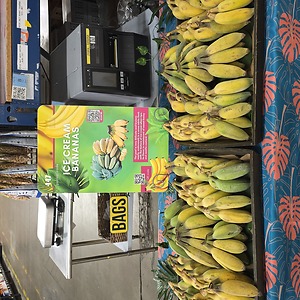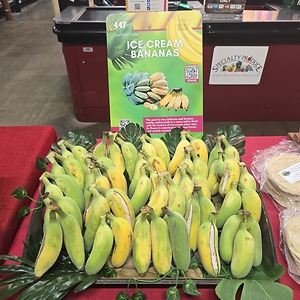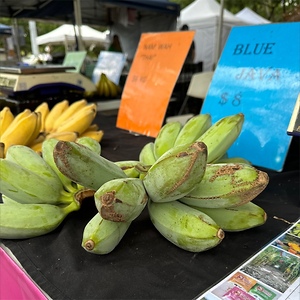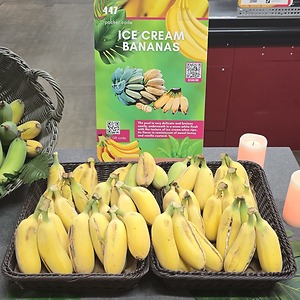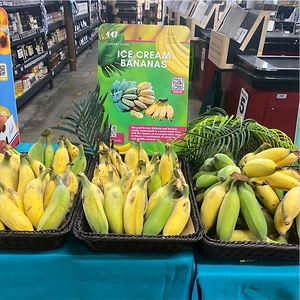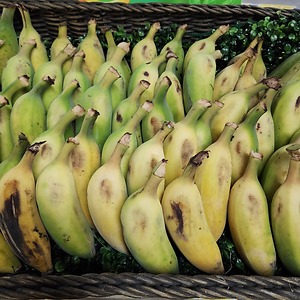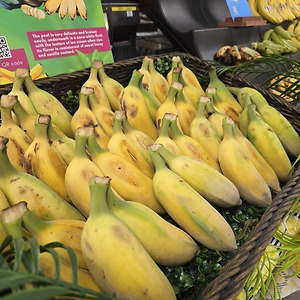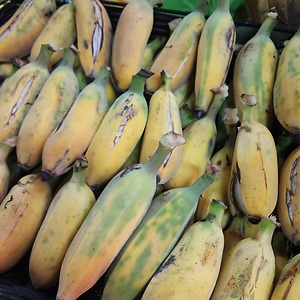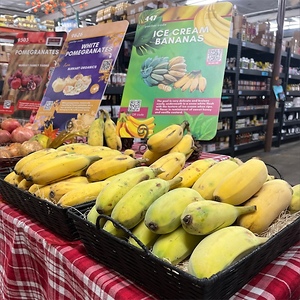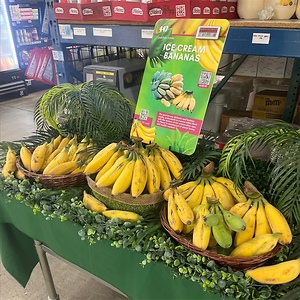

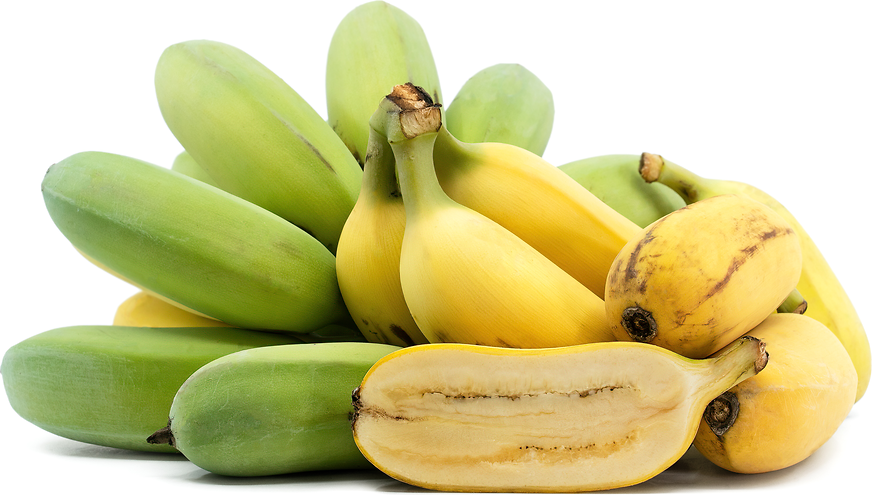
Ice Cream Bananas
Estimated Inventory, lb : 0
This item was last sold on : 07/20/25
Description/Taste
Ice Cream bananas grow in small bunches of 7 to 9 hands, and the fruits are shorter, stouter, and plumper than standard commercial bananas. Ice Cream bananas have an angular, cylindrical shape with blunt, curved ends, and the fruits are straight to slightly bent. Each banana ranges 18 to 23 centimeters in length and displays a semi-thick, tough, and smooth peel. Despite its hardy nature, the peel is susceptible to bruising but will not crack or split open. The fruits ripen from shades of dusty green to pale or canary yellow hues. It is vital to note that the fruits are sometimes coated in a layer of wax, giving them a blue-green to grey-green appearance when young and unripe. This coloring inspires the variety’s other well-known name: Blue Java bananas. Underneath the surface, the white-to-ivory flesh is solid, dense, creamy, soft, and tender. The fruit’s center also contains a few undeveloped black seeds that are edible and untraceable when eaten. Ice Cream bananas will detach from the hand when ripe and are determined to be mature by their coloring. The fruits are edible raw and have a sweet, subtly tart, and tangy taste with tropical, fruity, honeyed, and vanilla-like custard undertones.
Seasons/Availability
Ice Cream bananas are available year-round in tropical climates. In subtropical climates, the variety has a general peak season from late summer through fall.
Current Facts
Ice Cream bananas, botanically classified as Musa acuminata × Musa balbisiana, are a hybrid variety belonging to the Musaceae family. The fruits develop in small bunches on fast-growing plants reaching 4 to 6 meters in height. Ice Cream bananas are a triploid ABB variety, meaning they contain one set of chromosomes from their Musa acuminata parent and two sets of chromosomes from their Musa balbisiana parent. The variety is known for its hardiness and wind resistance, bearing strong pseudostems and root systems. It is also cold-tolerant, allowing it to be grown in regions where other banana cultivars cannot thrive. Ice Cream bananas are known by several names worldwide, including Blue Java, Cenizo in Central America, Krie in the Philippines, Hawaiian banana, Pata, or Vata in Fiji, Blue Lubin in Australia, Tarua Teatea in the Cook Islands, Fa’i Pata Sina and Pata Papalagi in Samoa, Pata Hina and Pata Lahelahe in Tonga, and Ney Mannan in India. The variety’s Ice Cream moniker is used primarily in the United States and is given to the fruits for their creamy texture, not flavor. Ice Cream bananas have a sweet and tangy taste with nuances of vanilla, showcased when consumed fresh. The bananas are also utilized in various desserts and can be cooked to enhance the depth of flavoring.
Nutritional Value
Ice Cream bananas are a source of vitamin C to strengthen the immune system, fiber to regulate the digestive tract, manganese to develop connective tissues, and vitamin B6 to maintain the nervous system. Like other bananas, the fruits may be a source of potassium to balance fluid levels within the body, magnesium to control nerve functions, calcium to protect bones and teeth, and other nutrients, including folate, thiamin, riboflavin, copper, zinc, phosphorus, iron, and vitamin K.
Applications
Ice Cream bananas have a sweet and tangy taste suited for fresh and cooked preparations. The variety is typically eaten out of hand and enjoyed for its smooth texture and vanilla-like flavor. Ice Cream bananas can be utilized in any recipe calling for common bananas. The fruits are sliced and mixed into fruit medleys, used as a topping over toast, acai bowls, and pancakes, or halved and eaten with peanut butter as a snack. Ice Cream bananas are also popularly added into smoothies and shakes or blended and frozen into ice cream. Try incorporating Ice Cream bananas into whipped cream, purees, and frostings, or use them for flavoring custards and panna cotta. The variety’s sweet taste shines in various desserts such as cakes, pies, tarts, and frying, or the fruits can be caramelized and savored as a rich topping. Ice Cream bananas can also be baked into muffins and bread. Ice Cream bananas pair well with agave syrup, maple syrup, vanilla, chocolate, spices such as cinnamon, allspice, and nutmeg, fruits including coconuts, blueberries, mangos, and citrus, and nuts such as walnuts, almonds, and peanuts. Whole, unopened Ice Cream bananas will keep up to one week at room temperature when ripe. It is recommended to immediately consume ripe bananas for the best quality and flavor. Ice Cream bananas can also be mashed and frozen or left whole and frozen for extended use.
Ethnic/Cultural Info
Ice Cream bananas are a popular variety in Hawaii planted in home gardens. Hawaii is known for being able to grow many types of tropical and subtropical banana cultivars, and bananas, in general, are intertwined with several ancient superstitions. Among fishermen, it is bad luck to bring bananas on a boat. This superstition derives from when Hawaiian fishermen traveled in large, dugout canoes. These canoes were used for exploration and transport, and when bananas were being carried in them, they had to be transported quickly to avoid spoiling. This led to the fishermen not having enough time to fish on these journeys, resulting in them saying it was bad luck. Longer voyages would also carry bananas to consume as a food source. Legend has it that these journeys often took longer than expected, and as they traveled across stretches of water, fish availability would come and go. This variation in fish led fishermen to believe that the bananas were causing the fish to not bite the lures. Bananas are still banned from boats among superstitious fishermen in Hawaii in the modern day, and the tale is often shared as interesting folklore among the islands.
Geography/History
Ice Cream bananas are native to Southeast Asia, possibly in the Indo-Malaysian region. Much of the variety’s history is unknown beyond being a triploid hybrid. Ice Cream bananas are a cross between Musa acuminata and Musa balbisiana, both wild species. Musa acuminata is native to the tropical forests in Southeast Asia and is commonly called the Cavendish group. Musa balbisiana is native to the northern monsoon regions of Southeast Asia and is referred to as the Plantain group. Since Ice Cream bananas are a hybrid of the two species, scientists believe their origins can be traced to an area where both parent species overlapped. Ice Cream bananas have naturalized in many regions throughout Southeast Asia and Oceania and many of the locals refer to these simply as wild fruits. Over time, the variety was also introduced worldwide, especially to Hawaii, and was grown as a home garden and small-scale commercial cultivar. Ice Cream bananas thrive in tropical to subtropical climates, and the fruits are harvested almost exclusively for culinary use. The leaves are also used in various applications, but the fruits are a fresh-eating and cooking cultivar. The variety received widespread notoriety in 2021 when photos of “Blue Bananas” went viral on social media, but unfortunately, many of these photos were of photoshopped and over-color-corrected Ice Cream bananas, skewing public perception. Today, Ice Cream bananas are found through local markets, specialty distributors, and directly from growers.
Featured Restaurants
Restaurants currently purchasing this product as an ingredient for their menu.
| Matsu | Oceanside CA | 760-717-5899 |
Podcast



